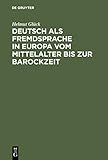Deutsch als Fremdsprache in Europa vom Mittelalter bis zur Barockzeit / Helmut Glück.
Material type: TextPublisher: Berlin ; Boston : De Gruyter, [2013]Copyright date: ©2002Description: 1 online resource (606 p.)Content type:
TextPublisher: Berlin ; Boston : De Gruyter, [2013]Copyright date: ©2002Description: 1 online resource (606 p.)Content type: - 9783110170849
- 9783110881158
- online - DeGruyter
| Item type | Current library | Call number | URL | Status | Notes | Barcode | |
|---|---|---|---|---|---|---|---|
 eBook
eBook
|
Biblioteca "Angelicum" Pont. Univ. S.Tommaso d'Aquino Nuvola online | online - DeGruyter (Browse shelf(Opens below)) | Online access | Not for loan (Accesso limitato) | Accesso per gli utenti autorizzati / Access for authorized users | (dgr)9783110881158 |
Browsing Biblioteca "Angelicum" Pont. Univ. S.Tommaso d'Aquino shelves, Shelving location: Nuvola online Close shelf browser (Hides shelf browser)

|

|

|

|

|

|

|
||
| online - DeGruyter Homilien zum Hexaemeron / | online - DeGruyter The Sublime in Kant and Beckett : Aesthetic Judgement, Ethics and Literature / | online - DeGruyter Der gesuchte Widerstreit : Die Antinomie in Kants Kritik der praktischen Vernunft / | online - DeGruyter Deutsch als Fremdsprache in Europa vom Mittelalter bis zur Barockzeit / | online - DeGruyter König David : Eine Biographie / | online - DeGruyter Annae Comnenae Alexias : Pars prior: Prolegomena et Textus. Pars altera: Indices / | online - DeGruyter Cooperating with Written Texts : The Pragmatics and Comprehension of Written Texts / |
restricted access online access with authorization star
http://purl.org/coar/access_right/c_16ec
Das Deutsche wird seit etwa 1200 Jahren als Fremdsprache gelernt. Die ältesten Zeugnisse sind mittelalterliche Glossare für Reisende. Im Hochmittelalter florierte die 'direkte Methode': Man lernte Volkssprachen durch mündliche Instruktion. Wirtschaftliche Interessen und Massenvertreibungen im Zeichen von Glaubenskonflikten intensivieren im Spätmittelalter und in der frühen Neuzeit die Nachfrage nach Kenntnissen des Deutschen. Systematischer Deutschunterricht ist im 15. Jahrhundert in Norditalien nachweisbar, und auch in Mittel- und Osteuropa wird in dieser Zeit Deutsch unterrichtet. Eine große Vielfalt von Sprachbüchern, Wörterbüchern, Übungsmaterialien und schließlich auch Lerngrammatiken entsteht im 16. Jahrhundert, und im 17. Jahrhundert existiert bereits ein breites Spektrum von Kozepten und Medien für den Erwerb des Deutschen. Dieses Buch zeichnet erstmals den Gang dieser Entwicklung bis zum Ende des 17. Jahrhunderts.
German has been studied as a foreign language for some 1200 years. The oldest documents are medieval glossaries for travellers. In the High Middle Ages, the 'direct method' predominated, with people learning the vernaculars through oral instruction. In the Late Middle Ages and Early Modern Ages, economic interests and mass expulsions resulting from religious conflicts led to an intensification of the need to learn German. There is evidence of systematic teaching of German in Northern Italy in the 15th century, and at this time German was also being taught in Central and Eastern Europe. The 16th century saw the production of a wide variety of language books, dictionaries, practice materials and finally also learners’ grammars, and in the 17th century there was already a broad spectrum of concepts and media for learning German. This book is the first to trace the course of this development up to the end of the 17th century.
Mode of access: Internet via World Wide Web.
In German.
Description based on online resource; title from PDF title page (publisher's Web site, viewed 17. Dez 2021)


